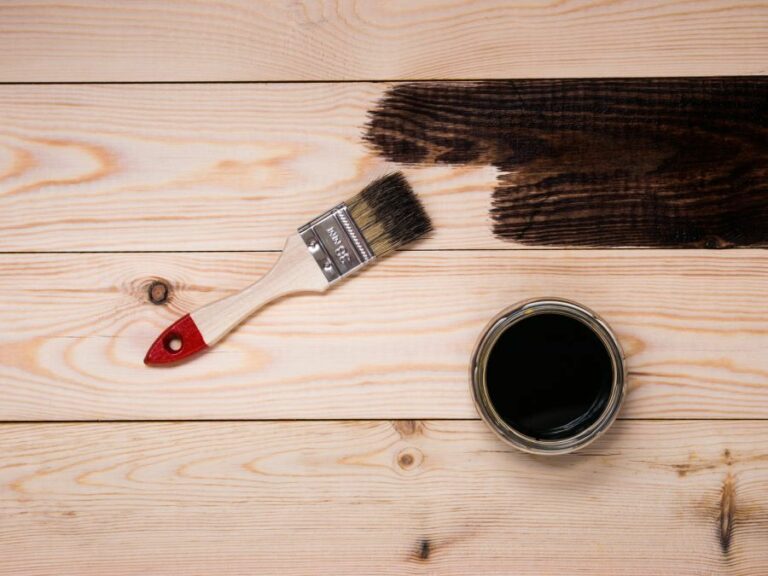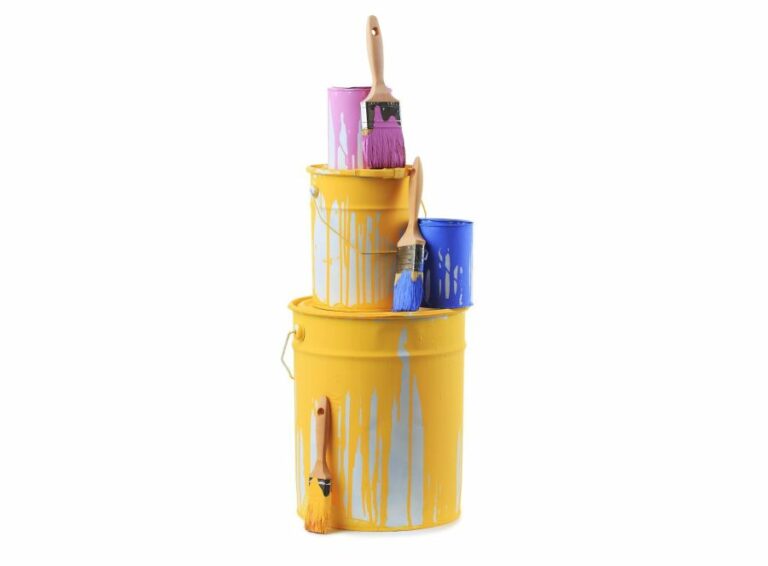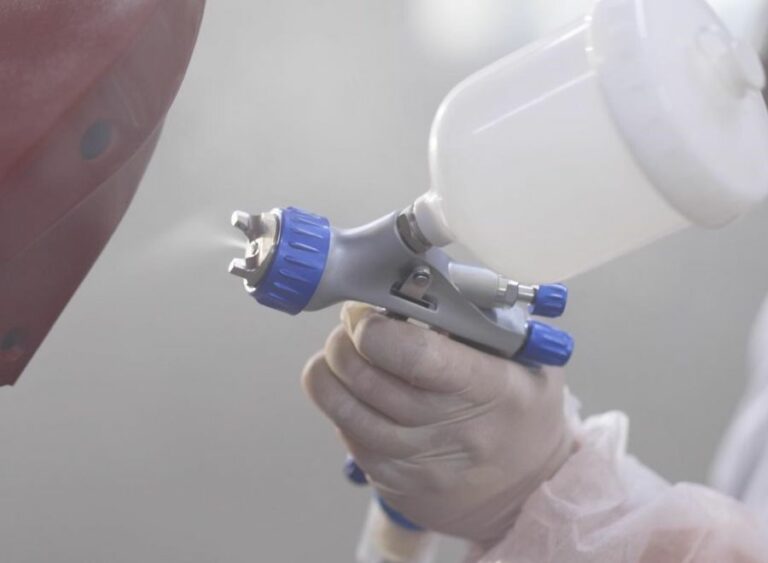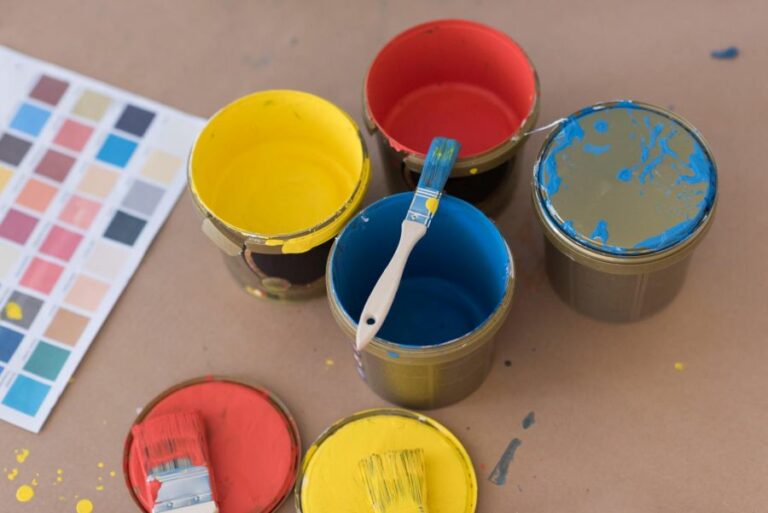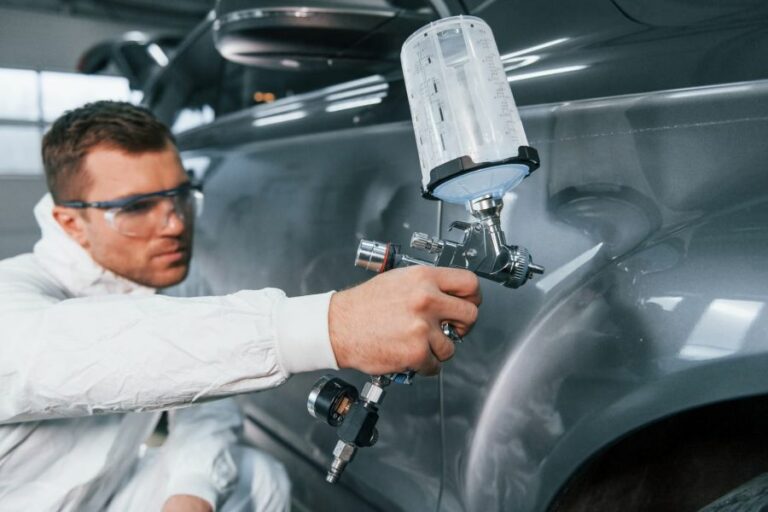How To Remove Spray Paint From Surfaces Inside And Out
Removing spray paint from various surfaces can seem quite challenging, but worry not; I’m here to help you tackle this task easily. Whether it’s your home’s interior walls or your favorite garden furniture exterior, I’ve got the tips and tricks you need to eliminate unwanted paint successfully.
How to remove spray paint from surfaces, inside and out:
To remove spray paint from surfaces, use pressure washing, chemical removers, or abrasive techniques for concrete; rubbing alcohol, acetone, or fine steel wool for metal; vegetable oil, baking soda paste, or lighter fluid for plastic; and a razor blade, rubbing alcohol, or glass cleaner for glass surfaces. Always test methods on a small area before proceeding with paint removal.

Struggling with unwanted spray paint on various surfaces? Worry no more! We’ve got your back with proven methods to tackle this issue both indoors and outdoors. Say goodbye to graffiti problems and unsightly stains. Read on for all the tips and tricks you need to restore your surfaces!
Contents
- 1 Eliminating Spray Paint from Indoor & Outdoor Surfaces
- 2 Interior Overspray Removal: Techniques & Tips
- 3 Effective Methods for Removing Spray Paint from Surfaces
- 4 Is Isopropyl Alcohol Effective for Spray Paint Removal?
- 5 Can WD-40 Successfully Eliminate Overspray?
Eliminating Spray Paint from Indoor & Outdoor Surfaces
Spray paint is an effective and convenient way of applying paint to various surfaces. However, it can sometimes end up on unintended surfaces, both inside and outside.
• Concrete Surfaces
Spray paint on concrete surfaces can be stubborn and difficult to remove. However, with the right approach and products, it is possible to get rid of unwanted paint.
– Pressure Washing
Pressure washing is a popular method for removing spray paint, especially from outdoor surfaces like sidewalks and driveways. High-pressure water can effectively break the paint bond with the concrete surface, making it easier to wash away.
Before using a pressure washer, it is crucial to ensure proper safety measures, including the use of protective gear such as gloves and goggles.
– Chemical Removers
Chemical paint removers, such as graffiti removers or paint thinners, can be effective for removing paint from concrete surfaces. Always test the remover on a small, inconspicuous area before applying it to the stained surface.
Remember to follow the manufacturer’s instructions and maintain proper ventilation during the process.
– Abrasive Techniques
For smaller spray paint stains on concrete, abrasive techniques such as sandblasting or using a wire brush can also be effective. This approach may damage the concrete surface, so it should be used cautiously and only when other methods have been unsuccessful.
• Metal Surfaces
Unlike concrete, removing spray paint from metal surfaces can be easier and less time-consuming. Some common methods for metal surfaces are:
– Rubbing Alcohol
Isopropyl alcohol or rubbing alcohol can be effective in removing spray paint from metal surfaces. Apply the alcohol to a soft cloth or cotton ball and gently rub the painted area. In most cases, the paint will dissolve and can be wiped away.
– Acetone
Acetone, found in many paint thinners and nail polish removers, can also remove paint from metal surfaces. Similar to rubbing alcohol, pour a small amount of acetone onto a cloth or cotton ball and rub it onto the paint stain.
Acetone is a powerful solvent, so it should be handled with care and used in a well-ventilated area.
– Fine Steel Wool
For more stubborn paint stains, fine steel wool, such as grade 0000 or 000, can be used along with a solvent like acetone or rubbing alcohol.
Gently rub the steel wool in a circular motion on the paint stain, being careful not to scratch the metal surface. This method is generally effective at removing paint without damaging the metal surface.
• Plastic Surfaces
Removing spray paint from plastic surfaces can be challenging, as plastic can be sensitive to chemicals and heat. However, the following methods can be effective and safe for most plastics:
– Vegetable Oil
For fresh spray paint spills, using vegetable oil can help to break down the paint without damaging the plastic surface. Apply the oil to a clean cloth or soft sponge and gently rub the painted area until the paint starts to lift.
– Baking Soda and Water Paste
A paste made from baking soda and water may be effective in removing spray paint from some plastic surfaces. Apply the paste to the painted area and let it sit for a few minutes. Gently rub the paste into the paint with a cloth or soft sponge until the paint starts to lift.
– Lighter Fluid
In some cases, lighter fluid may help to remove paint from plastic surfaces. Apply a small amount of lighter fluid to a cloth or soft sponge and gently rub the painted area. It is crucial to test this method on an inconspicuous area first, as it may damage some types of plastic.
• Glass Surfaces
Removing spray paint from glass surfaces is relatively straightforward, thanks to the nonporous nature of the material. Here are some popular and effective methods:
– Razor Blade or Scraper
Using a razor blade or a window scraper is an effective method for removing spray paint from glass surfaces.
Carefully scrape the edge of the paint stain, ensuring that the blade is held at a slight angle to prevent scratching. This method is best suited for larger paint stains on windows, mirrors, or glass tables.
– Rubbing Alcohol or Acetone
Similar to metal surfaces, rubbing alcohol or acetone can be used to remove spray paint from glass surfaces. Apply the solvent to a cloth or cotton ball and gently rub the painted area until the paint starts to dissolve and can be wiped away.
– Glass Cleaner
For smaller paint stains on glass surfaces, a commercial glass cleaner may be sufficient for removing the paint. Spray the cleaner directly onto the painted area and wipe with a clean cloth or paper towel.
In conclusion, there are various methods and approaches for removing spray paint from different surfaces. By choosing the right technique and using proper safety precautions, reclaiming a clean and paint-free surface is achievable.
Always research the specific material and test any methods or products in a discreet location before proceeding with the paint removal process.
Interior Overspray Removal: Techniques & Tips
Removing interior overspray is a common issue faced by individuals working on automotive or home improvement projects.
While it can be a daunting task, with the right tools, techniques, and patience, you can efficiently get rid of excess paint or material.
• Identifying the Type of Overspray
Before you attempt to remove interior overspray, it’s essential to identify the type of material you’re working with. Common materials include water-based paint, oil-based paint, and clear coat.
Knowing the kind of overspray will help you select the most appropriate removal method and products. If you’re unsure about the type of material, consult the manufacturer’s guidelines or seek expert advice from a professional.
• Removing Overspray from Glass Surfaces
1. Razor Blade Method
One of the most effective ways to remove overspray from glass surfaces, such as windows and mirrors, is by using a razor blade scraper. Follow these steps to ensure effective and safe removal:
- Clean the glass surface thoroughly using a mixture of water and a few drops of dish soap. This will remove any dirt or debris that could scratch the glass during the scraping process.
- Hold the razor blade scraper at a 45-degree angle against the glass surface.
- With gentle and slow strokes, glide the scraper across the glass, applying consistent pressure to remove the overspray. For stubborn areas, apply a bit of water to help ease the process.
- Continue this process until all overspray is removed from the glass.
- To finish, clean the glass surface again with water and dish soap and dry using a microfiber cloth.
Note: Always use extreme caution when handling razor blades, and wear protective gloves to avoid cuts or injuries.
2. Acetone or Rubbing Alcohol Method
For individuals who prefer not to use a razor blade, another effective method for removing overspray from glass surfaces is using a solvent, such as acetone or rubbing alcohol. Follow the steps below:
- Clean the affected area with water and dish soap.
- Apply a small amount of acetone or rubbing alcohol to a clean cloth or sponge.
- Gently rub the overspray with the solvent-soaked cloth in a circular motion, applying firm pressure until the overspray is gone.
- Rinse the area with water and clean it with a water-dish soap mixture.
- Dry the surface with a microfiber cloth.
Note: Always work in a well-ventilated area and wear protective gloves when handling solvents.
• Removing Overspray from Metal and Painted Surfaces
For metal and painted surfaces, use a clay bar or detailing clay to remove overspray. This method is less invasive and poses less risk of damaging the surface compared to scraping or using solvents. Follow these steps:
- Prepare a bucket of water with a few drops of car wash soap or dish soap.
- Dip the clay bar in soapy water, ensuring it remains saturated and pliable.
- Gently rub the clay bar over the overspray areas, moving in a back-and-forth motion, frequently dipping the clay bar in soapy water to maintain lubrication.
- Once the overspray has been removed, rinse the area with clean water and dry with a microfiber cloth.
- Optionally, apply a coat of wax to the surface to restore shine and protect the surface.
Note: Always follow the manufacturer’s instructions for the clay bar or detailing clay you’re using. Do not use a clay bar on surfaces with heavy rust or severe damage, as it can cause further damage.
• Removing Overspray from Upholstery, Carpet, or Fabric
For overspray on upholstery, carpet, or fabric, a steamer or extraction cleaner may be required. You can rent one from a local home improvement or auto supply store or seek help from a professional detailer. Alternatively, consider the following steps for minor overspray removal:
- Vacuum the area thoroughly to remove any loose debris.
- Gently scrape away any dry, loose paint with a plastic scraper or old credit card.
- Apply a fabric or upholstery cleaner to the affected area, following the manufacturer’s instructions. For water-based paint, a mixture of water and dish soap can be used.
- Gently dab the area with a clean, damp cloth or sponge, working from the outer edges towards the center to prevent spreading the overspray.
- Repeat this process until the overspray is gone, frequently rinsing the cloth or sponge and changing the cleaning solution as needed.
- Dry the area by dabbing with a clean, dry cloth or towel, and allow it to air dry completely.
Note: Always test the cleaner on an inconspicuous area of the material to ensure it doesn’t cause discoloration or damage.
• Safety Precautions and Recommendations
Remember to wear appropriate personal protective equipment (PPE), such as gloves, goggles, and masks, while dealing with overspray removal. Work in a well-ventilated area, and take breaks as needed to prevent prolonged exposure to chemicals or fumes.
Lastly, always follow the manufacturer’s instructions for any cleaning products or tools used during the process.
In conclusion, removing interior overspray requires patience, proper technique, and the selection of the most appropriate cleaning materials.
By following these guidelines, you can effectively restore various surfaces to their original condition, minimizing damage and preserving the overall appearance of your automotive or home improvement projects.
Step | Instructions |
|---|---|
1 | Inspect the affected area to determine the type and extent of the overspray. |
2 | Gather the necessary supplies, such as clean microfiber cloths, rubbing alcohol or a designated overspray removal product, a plastic scraper, and a mild soap and water solution. |
3 | Ventilate the area by opening doors and windows to ensure proper air circulation during the cleaning process. |
4 | Test the rubbing alcohol or overspray removal product on a hidden area of the affected surface to ensure it does not cause damage or discoloration. |
5 | Dampen a clean microfiber cloth with the rubbing alcohol or overspray removal product and gently rub the affected area in a circular motion. Apply steady pressure, but avoid rubbing too hard to prevent damage to the surface. |
6 | Use a plastic scraper to gently scrape away any stubborn overspray residue. Be careful not to scratch or damage the surface. |
7 | Clean the area with a mild soap and water solution to remove any remaining residue and the cleaning product. Rinse with clean water and dry with a clean microfiber cloth. |
8 | Inspect the area to ensure all overspray has been removed. If necessary, repeat the process until the overspray is completely gone. |
Effective Methods for Removing Spray Paint from Surfaces
• Precautionary Measures Before Removing Spray Paint
Before diving into the removal process, here are some essential precautionary measures for achieving the best results:
- Always wear gloves and protective gear when handling chemical-based paint-removal products.
- Work in a well-ventilated area to prevent inhaling harmful fumes from chemicals.
- Test the paint-removal technique on a small, inconspicuous area first to ensure it doesn’t damage the surface.
• Removing Spray Paint from Metal Surfaces
– Method 1: Using Acetone or Nail Polish Remover
- Soak a cloth or sponge in acetone or nail polish remover.
- Lay the cloth on the spray-painted area and let it sit for about 10 minutes.
- Rub the area with the cloth to remove the paint. If needed, repeat the process multiple times to remove all the paint.
I recommend using acetone or nail polish remover with care, as prolonged exposure to these liquids may harm the metal surface.
– Method 2: Using a Paint Thinner
- Apply the paint thinner using a cloth or sponge on the affected area.
- Let it sit for a few minutes, then use a clean cloth or sponge to wipe away the dissolved paint.
- Rinse the area thoroughly with water to remove any residual thinner.
• Removing Spray Paint from Wood Surfaces
– Method 1: Using Sandpaper
- Select a fine-grit sandpaper (120 or 150-grit) for light spray paint or a coarser grit (60 or 80-grit) for heavy paint.
- Start sanding the area firmly, following the wood grain to avoid creating scratches on the surface.
- When the paint has been removed, finish sanding with a fine-grit sandpaper to smooth out the surface.
– Method 2: Using a Paint Stripper
- Apply a paint-stripping gel or liquid to the spray-painted area.
- Let it sit for the recommended time on the product, usually around 15-30 minutes.
- Use a scraper or a plastic putty knife to gently scrape away the paint.
- Wipe the area clean with a damp cloth.
- If needed, lightly sand the surface with fine-grit sandpaper to even it out.
• Removing Spray Paint from Concrete Surfaces
– Method 1: Pressure Washing
- Set up a pressure washer with a medium pressure level.
- Hold the washer nozzle at an angle and begin spraying the affected area, keeping the nozzle about one foot away from the surface.
- Move in a sweeping motion to work the paint off the surface evenly.
- Repeat the process until the paint is gone, then let the area dry.
– Method 2: TSP (Trisodium Phosphate) Solution
- Mix a TSP solution, following the package instructions.
- Wet the affected area with the solution, using a bristle brush or a scrubber.
- Let the solution sit for 15 minutes, then scrub the area vigorously with the brush or scrubber.
- Rinse the area with clean water and allow it to dry.
Tri-sodium Phosphate is an efficient cleaning agent for removing spray paint from concrete surfaces. Always wear protective gear when working with TSP, as it can be harmful to the skin and eyes.
• Removing Spray Paint from Glass Surfaces
– Method 1: Using a Razor Blade
- Hold the razor blade at an angle against the surface, beginning at the edge of the spray-painted area.
- Gently scrape away the paint, being careful not to scratch the glass.
- Wipe the razor clean and move on to the next section until all the paint has been removed.
– Method 2: Using Acetone or Nail Polish Remover
- Soak a cloth or sponge in acetone or nail polish remover.
- Apply the soaked cloth on the spray-painted area and let it sit for about 10 minutes.
- Gently rub the area with the cloth to remove the paint, repeating the process if needed.
- Wipe the area clean with a damp cloth.
In conclusion, the process of removing spray paint from surfaces will vary depending on the material. Always test a small area first and follow safety precautions when using chemical-based removal products. With patience and persistence, you can restore your surface back to its original state.
Surface | Method |
|---|---|
Wood | Use sandpaper or a paint scraper, followed by a paint thinner or acetone on a cloth. |
Metal | Use paint thinner, acetone, or a dedicated graffiti remover. Alternatively, use a fine steel wool or sandpaper. |
Glass | Use a razor blade or paint scraper. Alternatively, use rubbing alcohol or acetone on a cloth. |
Stone/Concrete | Use a graffiti remover or paint stripper. Alternatively, use a power washer or sandblasting. |
Plastic | Use a plastic-safe paint remover, baking soda, or vegetable oil on a cloth. |
Is Isopropyl Alcohol Effective for Spray Paint Removal?
Removing spray paint can be a challenging task, particularly when the paint has dried and adhered to the surface. One of the most commonly used solutions for removing spray paint is isopropyl alcohol, also known as rubbing alcohol.
• Isopropyl Alcohol as a Spray Paint Remover
Isopropyl alcohol is a powerful solvent that can be used to dissolve a wide range of substances, including spray paint. The alcohol works by breaking down the paint’s chemical bonds, making it easier to remove from the surface.
– Pros of Using Isopropyl Alcohol
- Easily Available: Isopropyl alcohol can be found in most drugstores and supermarkets, making it an easily accessible option for removing spray paint.
- Cost-effective: Rubbing alcohol is generally inexpensive, making it a cost-effective solution for removing small or large amounts of spray paint.
- Versatile: Isopropyl alcohol can be used on various surfaces, including metal, glass, and plastic, without causing damage.
- Environmentally Friendly: Compared to other paint removal methods, isopropyl alcohol is less harmful to the environment due to its low toxicity.
– Cons of Using Isopropyl Alcohol
- Not Suitable for All Surfaces: Isopropyl alcohol may damage certain surfaces, such as wood or some types of paint or finishes. It is crucial to test the alcohol on a small, inconspicuous area before using it on the entire surface.
- Ineffective in Some Cases: Depending on the type of spray paint and how long it has been on the surface, isopropyl alcohol may not be the most effective option for removing the paint.
- Flammable: Isopropyl alcohol is a flammable substance and must be used with caution. Ensure proper ventilation and avoid using alcohol near open flames or heat sources.
• Applying Isopropyl Alcohol for Spray Paint Removal
When using isopropyl alcohol to remove spray paint, follow these steps:
- Safety precautions: Wear protective gloves and ensure proper ventilation to avoid inhaling fumes.
- Apply isopropyl alcohol: Moisten a clean cloth or sponge with the alcohol solution and gently rub the surface covered in spray paint.
- Scrub the surface: For stubborn paint, use a soft-bristled brush or sponge to scrub the surface gently.
- Wipe away the paint: As the paint begins to dissolve, use a clean cloth or paper towel to wipe away the loosened paint residue.
- Repeat as necessary: If the paint remains, repeat the steps until the spray paint is removed.
- Clean the surface: Once the spray paint is removed, clean the surface with mild detergent and water to remove any residue.
• Alternatives to Isopropyl Alcohol
If isopropyl alcohol is not effective in removing the spray paint, consider these alternatives:
- Acetone: Acetone, a powerful solvent often found in nail polish removers, can be used in place of isopropyl alcohol for removing spray paint. However, it is more hazardous and should be used with care.
- Paint Thinner: Paint thinner is a strong solvent specifically designed for removing paint. Always follow the manufacturer’s instructions for proper use and safety precautions.
- Graffiti Remover: Commercial graffiti removers are available for removing spray paint. These products typically contain solvents designed to break down paint and can be a highly effective solution. Always follow the product’s recommended usage guidelines.
- Pressure Washing: For exterior surfaces or large-scale paint removal, using a pressure washer may be effective in removing spray paint. This method involves using high-pressure water to blast away the paint, making it a non-chemical option for removal.
• Conclusion
Isopropyl alcohol can be an effective and widely available solution for removing spray paint from various surfaces. However, its effectiveness may vary depending on the paint type and surface being treated.
By taking precautionary measures and using proper application techniques, you can significantly increase the chances of successful paint removal. If isopropyl alcohol does not work, there are alternative methods available to remove spray paint.
Ultimately, the best method will depend on the specific situation and the surface being treated, and it is crucial to research the best option for your needs.
Can WD-40 Successfully Eliminate Overspray?
Overspray refers to the unintended deposition of paint particles that land on surfaces other than the intended target.
This often happens during spray painting, which can cause a mess, particularly on vehicles, glass, and other smooth surfaces. WD-40, a popular multi-purpose solution, is often hailed as a go-to solution for removing overspray.
• WD-40’s Effectiveness in Removing Overspray
WD-40 is a versatile, petroleum-based lubricant, and penetrating oil that is known for its ability to loosen rusted parts, displace moisture, and remove grease and grime. Its formulation includes a mixture of aliphatic hydrocarbons, which can dissolve some kinds of paint, particularly oil-based ones.
When it comes to removing overspray, WD-40 can be effective on certain surfaces like glass, metal, and some plastics.
By applying the product directly to the affected area and gently rubbing it with a clean cloth or microfiber towel, many users have reported success in removing unwanted paint splatters.
However, the effectiveness of WD-40 in dealing with overspray can vary depending on the paint type, surface material, and the duration of the paint’s exposure to the surface.
Some paint types, particularly water-based ones or those that have dried for a prolonged period, might not dissolve easily when treated with WD-40.
• Alternatives for Removing Overspray
While WD-40 might work for some cases, there are alternative methods and products that can be used to remove overspray. Different methods are effective for various surfaces and paint types.
– Clay Bar
For automotive surfaces and other smooth surfaces, a clay bar can be a great tool for removing overspray. Used widely by professional detailers, clay bars are designed to lift contaminants off the surface without damaging the paint underneath.
Ensure that the surface is well lubricated before using a clay bar, as this reduces the chances of scratching the surface.
– Acetone or Paint Thinner
For more stubborn overspray, particularly those that have dried, using acetone or paint thinner can be more effective.
When opting for this method, always test a small area first, as these solvents can potentially damage fragile surfaces. Use disposable gloves and a clean cloth to apply the chemical and remove the overspray.
– Rubbing Alcohol
For surfaces that may get damaged by stronger solvents like acetone, rubbing alcohol (isopropyl alcohol) may be used as a safer alternative.
This mild solvent works well on many surfaces, including glass and some plastics, without causing damage. It is especially effective for removing water-based paints.
– Scrapers
For glass surfaces, using a razor blade or a specialized scraper can be effective in removing overspray. Hold the blade at a low angle to avoid scratching the glass, and gently scrape away the paint. Be extra cautious when using this method on surfaces other than glass, as it can potentially cause damage.
• Safety Precautions
When using chemicals like WD-40, acetone, or paint thinner to remove overspray, always follow safety precautions:
- Always work in a well-ventilated area to avoid inhaling fumes.
- Wear appropriate protective gear, including gloves and eye protection.
- Test a small inconspicuous area before applying the chemical to the entire surface to avoid potential surface damage.
• Conclusion
In conclusion, WD-40 can work in removing overspray on some surfaces and paint types, but its effectiveness can vary. Alternative methods, such as clay bars, acetone, rubbing alcohol, or scrapers, can be more effective in certain cases.
Always keep in mind the specific surface material and paint type when selecting a removal method, and follow safety precautions when dealing with chemicals.


